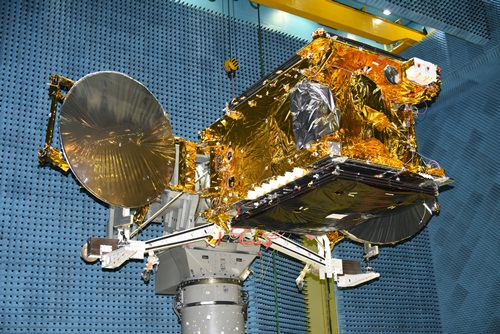India today successfully launched its latest and most powerful communication satellite GSAT-30 from the European Space Agency’s spaceport in French Guiana during the early hours of the day.
The launch was carried out using European Space Agency’s launch vehicle Ariane. The Ariane 5 VA-251 lifted off from the Kourou launch base in French Guiana at 2:35 am IST carrying India’s GSAT-30 and EUTELSAT KONNECT for Eutelsat, as scheduled.
After a flight lasting 38 minutes 25 seconds, GSAT-30 separated from the Ariane 5 upper stage in an elliptical Geosynchronous Transfer Orbit, Isro stated in a release.
With a lift-off mass of 3,357 kg, GSAT-30 will provide continuity to operational services on some of the in-orbit satellites. GSAT-30 derives its heritage from Isro’s earlier INSAT/GSAT satellite series and will replace INSAT-4A in orbit.
"A strong start to 2020 as Ariane 5 successfully deploys its two satellite passengers - EUTELSAT KONNECT and GSAT-30 - into geostationary transfer orbit! I appreciate the trust from the two customers on this mission: Arianespace CEO Stephane Israel tweeted confirming the successful launch.
Isro's UR Rao Satellite Centre Director P Kunhikrishnan, who was present in Kourou, congratulated the Isro community and Arianespace team on the successful launch.
Calling it an "excellent start" to 2020 for Isro with the launch, he said, "The mission team at the master control facility have already acquired the satellite and they will immediately complete the post launch operations...."
The 3,357-kg satellite is configured on Isro's enhanced I-3K Bus structure to provide communication services from Geostationary orbit in C and Ku bands. The communication payload of GSAT-30 is specifically designed and optimised to maximise the number of transponders on the spacecraft bus, Isro stated.
“GSAT-30 has a unique configuration of providing flexible frequency segments and flexible coverage. The satellite will provide communication services to Indian mainland and islands through Ku-band and wide coverage covering Gulf countries, a large number of Asian countries and Australia through C-band” Isro chairman K Sivan said.
“GSAT-30 will provide DTH television services, connectivity to VSATs for ATM, stock exchange, television uplinking and teleport services, Digital Satellite News Gathering (DSNG) and e-governance applications. The satellite will also be used for bulk data transfer for a host of emerging telecommunication applications,” Sivan added.
Isro’s Master Control Facility (MCF) at Hassan in Karnataka took over the command and control of GSAT-30 immediately after its separation from the launch vehicle. Preliminary health checks of the satellite revealed its normal health.
In the days ahead, Isro will carry our orbit-raising manoeuvres to place the satellite in Geostationary Orbit (36,000 km above the equator) by using its on-board propulsion system.
During the final stages of its orbit raising operations, the two solar arrays and the antenna reflectors of GSAT-30 will be deployed. Following this, the satellite will be put in its final orbital configuration. The satellite will be operational after the successful completion of all in-orbit tests.





















